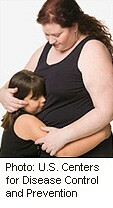
WEDNESDAY, Nov. 23 (HealthDay News) — Today’s kindergarteners are heavier than kids brought up in the 1970s and 1980s and appear to be on the road to becoming overweight and obese in the years to come, a new study finds.
“It’s not just kids who are already overweight getting more and more so, there is an entire shift. Even those who are normal weight are gaining weight,” said lead study author Ashlesha Datar, senior economist at RAND Corp. in Santa Monica, Calif.
Researchers analyzed data on nearly 6,000 white, black and Hispanic children who participated in the Early Childhood Longitudinal Study — a nationally representative sample — and had their height and weight measured over nine years, in kindergarten, first, third, fifth and eighth grades.
The study found nearly 40 percent of kindergarteners had a body mass index (BMI) in the 75th percentile or above, up from 25 percent in the 1970s and 1980s, when the growth charts were developed by the U.S. Centers for Disease Control and Prevention.
While a BMI in the 75th percentile is still in the normal range, that child may be headed for being overweight or obese, Datar said. And if they’re already at the 75th percentile in kindergarten, they don’t have far to go before they tip into the overweight or obese category, which puts them at risk of serious health problems as adults.
Traditionally, a BMI in the 85th to 95th percentile is considered overweight, while above the 95th percentile is obese. The number of kids at the top of the scale has swelled too.
About 28 percent of kids from the current sample had a BMI in the 85th to 95th percentiles, compared with 10 percent of earlier generations, while 12 percent had a BMI above the 95th percentile, compared with 5 percent of the earlier group of kids.
Gains in BMI were most striking among Hispanic children and black girls, according to the study, published in the December issue of Pediatrics.
Percentile measures how a child stacks up to others his age. So, a child in the 75th percentile for weight is presumably heavier than 75 percent of other children his age, since children are compared to one another. Therefore, by definition, 25 percent of kids should be in that category.
But with so many kids heavier then they used to be, the old weight distributions may not hold up, Datar said.
There were also fewer kids at the lower end of the weight spectrum. About 14 percent were in the lowest fourth for weight compared with 25 percent in earlier generations and 18 percent were in the second lower quartile compared with 25 percent in earlier generations.
The weight gain accelerated between kindergarten and third grade. The proportion of kids in the top quartile (75th percentile or above) was almost 48 percent by third grade, but weight gain leveled off after that.
Experts said the findings show that to make an impact on skyrocketing childhood obesity rates, programs to encourage better eating habits and more physical activity have to start very early, possibly even in preschool. Those programs also need to include kids who are normal weight.
“If you find your child is in the 75th percentile, it should be warning to you that your child is at higher risk of being an obese adult, and you need to start thinking about what your family is doing as far as eating habits, food intake and exercise,” Datar said.
The reasons that America’s kids are getting heavier overall aren’t fully understood, but there are many possibilities, said Dr. Albert Rocchini, a professor of pediatrics at University of Michigan’s C.S. Mott Children’s Hospital.
These include the ready availability and convenience of high-fat, high-sugar and highly caloric snack and processed foods and less physical activity because of video games, TV and less outdoor play time. Many families rely more on fast food and restaurant food, which tend to pack more calories than home-cooked food.
“This study reinforces what people are noticing, and it’s a little discouraging,” said Rocchini. “The incidence of obesity is going up because everybody is getting heavier,” he said.
For health reasons, it’s important to get a child’s weight gain under control, he added. A study recently published in the New England Journal of Medicine found that obese children who became obese adults were at much higher risk of type 2 diabetes, high blood pressure, high cholesterol and atherosclerosis.
More information
The American Academy of Child & Adolescent Psychiatry has more on childhood obesity.

